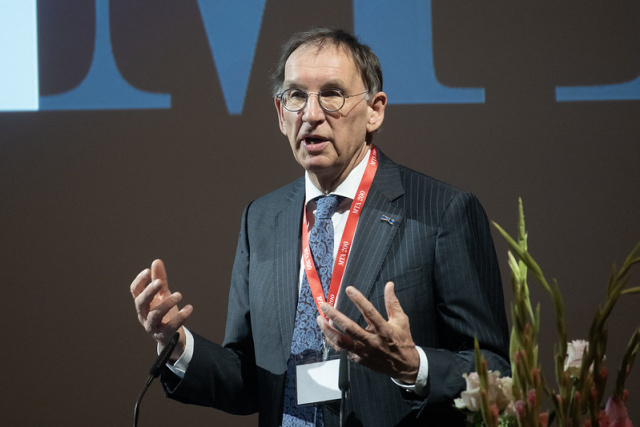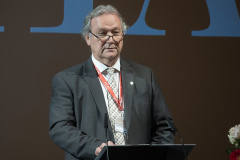Building trust and timeliness in science advice: Professor Wim van Saarloos on strengthening the bridge between research and policy
Professor Wim van Saarloos, physicist and former president of the Royal Netherlands Academy of Arts and Sciences, has long grappled with how to make scientific advice more effective. The professor sat down with the Hungarian Academy of Sciences (MTA) at its 200th anniversary celebration and international conference in Budapest on 4 November to discuss this and other topics relevant to European science policy today. As President of the European Academies Science Advisory Council (EASAC), he emphasised that bridging the gap between research and political decision-making requires foresight, focus and constant adaptation.
Science advice, he said, only works when it arrives at the right moment. “Timing is of the essence – you have to bring advice at the right moment,” van Saarloos explained. In Brussels, where policy cycles can move swiftly and unpredictably, anticipating emerging issues is essential. Preparing a full EASAC report typically takes more than a year, so identifying debates before they reach the legislative stage is crucial. “You have to have your feelers out,” he added, describing how both European and national academies must stay alert to the policy agenda and sense where their input will matter most.
 Wim van Saarloos Photo: mta.hu / Tamás Szigeti
Wim van Saarloos Photo: mta.hu / Tamás SzigetiThat early awareness, however, is only one part of the challenge. The professor pointed out that the translation of complex science into accessible advice is an ongoing learning process for academies. Traditional reports, often running to 50 or 60 pages, are rarely read by time-pressed policymakers; the solution, he said, lies in developing concise, targeted materials as well. EASAC now routinely produces one- or two-page summaries or fact sheets, presenting key findings without diluting scientific integrity. “Hardly any politician reads more than a page and a half,” he remarked, noting that the ability to condense research without oversimplifying it “is something scientists are learning.”
Professor van Saarloos believes that this process of translation should begin long before a report is finished. As projects progress, he encourages EASAC working groups to focus early on what their main messages will be and how best to communicate them. The effort, he said, is not just about clarity but also about relevance – making sure that reports align with the policy window in which they can have the greatest impact.
Speed has become another decisive factor. “The pace of politics is going up everywhere,” van Saarloos observed. To keep up with this pace, EASAC has started issuing short commentaries that update or contextualise previous reports in light of new developments. By revisiting earlier work on topics such as energy or biodiversity, the council can respond rapidly to shifting debates while grounding its advice in prior evidence.
This adaptive approach is reflected in EASAC’s recent output. The council published three major reports in 2024: on securing sustainable energy supplies, on the growing threat and prevention of wildfires, and on meat alternatives, ranging from plant-based substitutes to lab-grown products. “Those three kept us very busy,” van Saarloos noted, explaining that they coincided with leadership changes within the organisation, as two new programme directors took office.
Looking ahead, EASAC’s forthcoming reports will address several pressing topics. A short commentary on the EU’s Nature Restoration Regulation is in preparation, alongside an in-depth study on the systems aspects of energy – how energy, climate and technology interlink. Another key report will focus on the application of artificial intelligence in healthcare. These studies, van Saarloos said, reflect EASAC’s dual mission:
to provide independent, evidence-based advice and to address the most urgent scientific questions facing Europe.
Maintaining that balance between independence, clarity and depth is one of his central concerns. The credibility of science advice, he stressed, depends on rigorous, transparent methods. “Credibility is based on doing an in-depth study,” he explained. EASAC does not conduct new research itself but synthesises the current state of knowledge and identifies policy implications. The goal is always to offer accessible and independent advice without losing the evidence base that underpins it. “I want to avoid that we only have short documents where you don’t have the evidence,” he said. “The underlying study is essential for maintaining trust.”
That trust has become increasingly fragile in the public sphere. Across Europe, academies are confronting the dual challenge of disinformation and declining confidence in science. Van Saarloos believes that institutions like EASAC and the Hungarian Academy of Sciences (MTA) have a vital role to play in restoring that trust.
He praises MTA’s outreach initiatives – particularly its alumni network and school-visiting programmes – as examples other academies can emulate.
“Even the National Academy of Sciences US can learn from what MTA is doing,” he remarked.
The deeper issue, he argued, is that much of traditional science communication has focused on celebration rather than explanation. “Most of science communication has been like ‘Oh, look what I’ve done, how wonderful it is,’” he reflected. Instead, he advocates greater public understanding of how science works: its self-correcting nature and its openness to new evidence.
One initiative he cited with approval is Sense About Science, a British charity promoting evidence-based public discourse. Its motto, “Ask for evidence,” captures an approach he believes both citizens and politicians should adopt. Encouraging people to question the basis of scientific claims, he said, is fundamental to building resilience against misinformation.
Yet the line between communication and advocacy can be delicate. Scientists must engage in public debate, but they also risk overstepping their expertise. “There is a tension between getting involved in the debates, which in a way we have to do, and scientists talking about issues beyond their expertise,” van Saarloos admitted. Finding that balance, he added, “is one of the important issues, too.”
Ultimately, his message is that effective science advice is not a matter of speaking louder but of speaking smarter – at the right time, in the right way, and with the right degree of humility. For Professor van Saarloos, strengthening the bridge between research and policy depends on three things: anticipation, translation and trust. If academies can master those, they will not only inform decision-making but help rebuild confidence in science itself.

